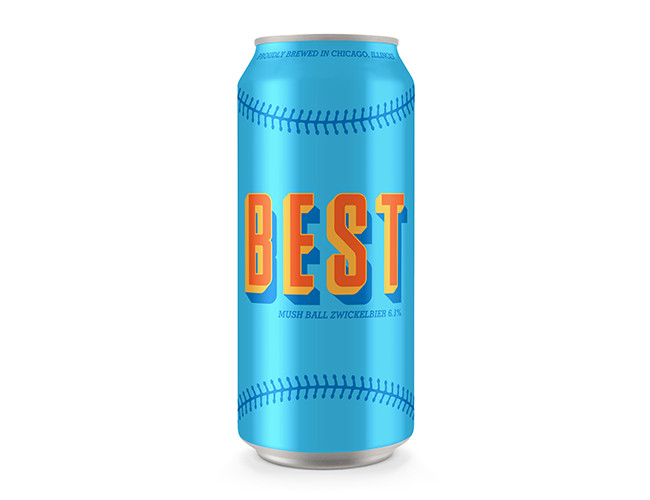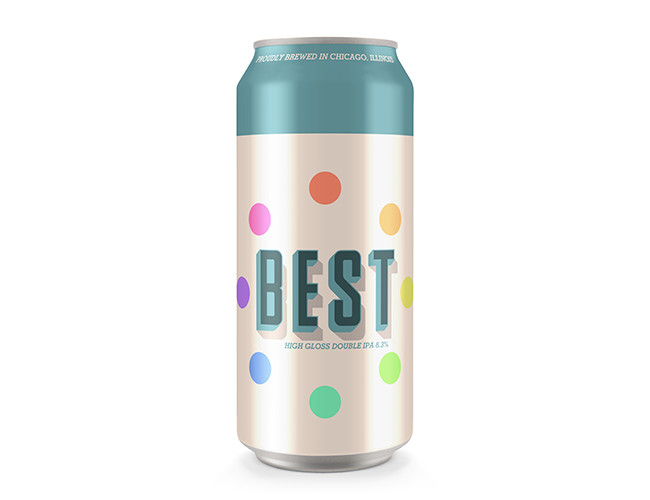Shop
Resurrect Beer Project: Best Brewing from Chicago
To revive a forgotten Chicago brewery, we looked toward graffiti, baseball, Twinkies and zippers.
In early 2017, we heard about a gentleman from Upstate New York who was beginning an ambitious project. With “Resurrect Beer,” designer PJ Engel is creating new branding and packaging for a defunct brewery from each state. The project is a fascinating lesson in history, design, and culture.
This week, the #resurrectseries takes on “Best Brewing” from Chicago, Illinois. After finding this name in research for this week, I couldn’t stop thinking of the song “You’re the Best” from Karate Kid. (I may have listened to it a bit while making these cans.) In the shadow of neighboring Milwaukee, Chicago still managed to carve a name for itself in the pre-prohibition era. Starting in 1865 as Martin Best brewery, it continued under various “Best” names until closing in 1961. The vacant building has since been converted into loft apartments. Hopefully one of the tenants is home brewing in their kitchen to keep the site churning out some tasty suds.
Mush Ball

Style: Zwickelbier
ABV: 6.1 percent
Description: One sport that most Americans have tried at some point is softball. Chicago was the birthplace of softball beginning in 1887. Designed for a smaller field and larger ball, it was meant to be played indoors. Earlier names for the game were: indoor baseball, playground, kitten ball, ladies baseball, and the name for today’s beer: mush ball. Since most recreational players enjoy being in a “beer league”, I thought the sport deserved its own beer.
Rotary

Style: Dry-hopped wheat
ABV: 5.8 percent
Description: The first meeting of the now Rotary Club occurred in Chicago. Paul P. Harris called together fellow businessmen in February of 1905 to create a group that would give back to the community. They chose the name Rotary because initially they rotated the meetings through each member’s office. Before researching this theme, I was aware of the club only by seeing their logo on road signs in every city. I now know that they tackle worldwide problems in six main areas: promoting peace, fighting disease, providing clean water, saving mothers and children, supporting education, and growing local economies. Anyone who volunteers for these causes deserves a beer at the end of the day.
Golden Cream Ale

Style: Cream ale
ABV: 4.8 percent
Description: The iconic American snack, the Twinkie, was created in 1930 in Chicago. The baker was tinkering with a solution for idle machines while strawberries were off-season for shortcake filling. Originally the filling was banana cream but rationing caused a switch to vanilla cream. The name Twinkie was an early moniker which was created after seeing a billboard for Twinkle Toe Shoes. When a product becomes as famous as the Twinkie, it weaves its way into our lives regardless of actual consumption. In the cult classic UHF, Weird Al crafts a Twinkie Weiner Sandwich. Ghostbusters used the scale of a Twinkie as an impromptu scale for the volume of paranormal activity, with the line, “that’s a big Twinkie”. Then we have the Twinkie defense. Used in the San Francisco murder trial of Harvey Milk and George Moscone, the defense attempted to claim that a diet of sugary foods caused the depression that spurred the murders. The last time I consumed a Twinkie was at a summer fair. It was deep-fried. There was remorse afterwards.
High Gloss

Style: Double IPA
ABV: 8.3 percent
Description: Today’s subject is a favorite of mine: spray paint. Graffiti has held a special place for me since I began listening to hip hop in middle school. Being one of the original pillars alongside breaking, MC’ing, and DJ’ing; it was a package deal, exposing myself to a culture far from my upbringing. “High Gloss” is a reference to spray paint, which was invented in Chicago in 1949 by Edward Seymour. A great short read on #graffiti is “Bomb the Suburbs” by William Upski Wimsatt.
Hookless Farm Ale

Style: Wild ale
ABV: 6.2 percent
Description: In 1851 the zipper was invented in Chicago by Whitcomb L. Judson. Zip, fly, zip fastener, clasp locker, and workable zipper are a few monikers for this closure. Originally called the hookless fastener, the interlocking teeth design hasn’t changed much since inception. This may remind you of curiosity about the “YKK” on zippers. They are a Japanese company that holds 45% of the zipper market. Yeah, there is a zipper market. Now there is a zipper beer.
Next Week: Arkansas


